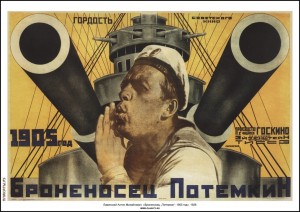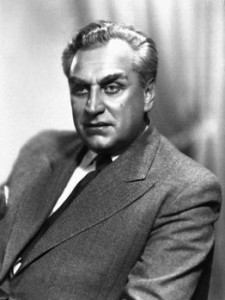By Laurel Tisserand
“Of all the arts, for us cinema is the most important.”- Lenin
Introduction:Propaganda was an essential ingredient to the Bolshevik reign. It helped them to both attain and maintain power in russia and it’s empires. One of the major tools used to spread the Communist message was that of film. Although films were not an effect tool to use on the peasantry, they were a very useful form of propaganda in cities, and ended up having an impact on, and being impacted the economy, politics, and the technology of the era. I will be looking at Soviet cinema from the period of the October Revolution to the death of Stalin.Overview Sources:1. Kino: A History of Russian and Soviet Film. By Jay Leyda. Third Edition. Princeton University Press, New Jersey, 1983.
-This hefty book contains what the author refers to as a “documented account of the artistic development of Soviet cinema”. This document carefully traces the lives and works of Soviet filmmakers and looks at the context of their films. It may be long, but it’s also beautifully written and offers a more artistic focus than most of the books written on the subject.
(Can be found at the BU Mugar Library
2. Soviet Cinema, Progress Publishers, Moscow.
-The final, and most intriguing book that I intend to use, is very mysterious. It has no date of publication, author, or publishing information at all really. All I know of the book is that it’s called Soviet Cinema and has these words printed on the back page:
“Progress Publishers would be glad to have your opinion of this book, it’s translation and design and any suggestions you may have future publications. Please send all your comments to 17, Zubovsky Boulevard, Moscow, USSR.”
That said, this book obviously offers the perspective of the USSR when it still existed. I can’t imagine this is easy to come by, but it is especially helpful when writing a paper that looks at periods where Lenin and Stalin were in power.
(Can be found at the BU Mugar Library)
Relevant Period:
3. Motion Picture in the Soviet Union, 1918-1952. By John David Rimberg. Arno Press, New York, 1973.
-This Dissertation analyzes the sociological implications of Soviet cinema by arguing that volume of production and content of soviet film were brought about by compromise between the Party, the people, and the filmmakers themselves. Rimberg explains the citizens’ need for entertainment, the Party’s need for propaganda distribution, and the filmmakers need for artistic freedoms. Rimberg is also a useful source because he is directly focusing on the period that I intend to address in my paper.
(Can be found at the BU Mugar Library)
4. Stalinism and Soviet Cinema. Edited by Richard Taylor and Derek Spring. Routledge, London and New York,1993.
-This source collects a number of useful sources together and delivers them in a well structured, easy to read package. Some of the articles aren’t particularly relevant while others are extremely useful to my topic. In particular, the chapter: “Canons and Careers: The Directors in Soviet Cinema” offers a broader context for my source number three, while the chapter, “The 1930’s and 1940’s: Cinema in Context” directly addresses the time period I’m writing on.
(Can be found at the BU Mugar Library)
5. Movies for the Masses: Popular Cinema and Soviet Society in the 1920’s. By Denise J. Youngblood. Cambridge University Press, Great Britain, 1992.
-This book examines popular soviet cinema in the 1920’s. It does so by looking closely at popular film works of the period and their impact on audiences. Youngblood makes the argument that during the first decade after the october revolution, Soviet cinema was greatly influenced by the middle class and western society.
(Can be found at the Boston Public Library)
Economy:
6. Soviet Cinema, 1929-1941: The Development of Industry and Infrastructure. By Jamie Miller. From Europe-Asia Studies, vol. 58 no. 1, 2006, 103-12.
-This article focuses the technical issues involved in Soviet cinema and makes the argument that a lack of equipment and technical advancement hindered the Soviet film industry. It specifically focuses on the issue of sound recording equipment within the industry. The article also touches on the industry’s economic impact and film distribution during the period.
(Can be found at JSTOR.com)
Politics:
7. Politics of the Soviet Cinema. By Richard Taylor. Cambridge University Press, Great Britain, 1979.
-This source looks at the political function of Soviet film in the 1920’s. It examines cinema’s roll in societal development, as well as how political authorities of the era both viewed and used cinema. This is done by first addressing Russian cinema that came before the October revolution, and then going on to discuss the roll of film as propaganda for the Bolsheviks.
(Can be found at the BU Mugar Library)
8. Federal Cinema: The Soviet Film Industry, 1924-32. By Vance Kepley, Jr. From Film History Vol. 8, 1996, 344-356
-This source is similar to many of the book sources I listed above. It offers a thorough history of soviet cinema in the distinguished period, but in a much more condensed form than the books above. A good source for an overview of soviet cinema, rather than the small details.
(Can be found at JSTOR.com)
Directors:
Soviet Film Directors, Memphis, 2011, Reference Series.
-This books is essentially an encyclopedia of Soviet film directors. It organizes the directors into alphabetical order and then offers information on them which can include anything from a list of their works to a brief biography of their lives. It is very useful for if one wishes to gain some perspective on the artists behind the films, rather than the impact of the films themselves.
(Can be found at the BU Mugar Library)
Some Useful Films to Watch
1. October
-Because I’m writing on the period from the October Revolution to the death of Stalin, it is important to look at the film that is an account of the October Revolution (from the Bolsheviks’ viewpoint, of course).
2. Mosfilm
-This Youtube channel has tons of useful soviet films to watch that will offer insight and context to the cinema of the soviet union.
-This was one of Stalin’s favorite films and starred one of the most popular actresses in Soviet cinema, Lyubov Orlova.



